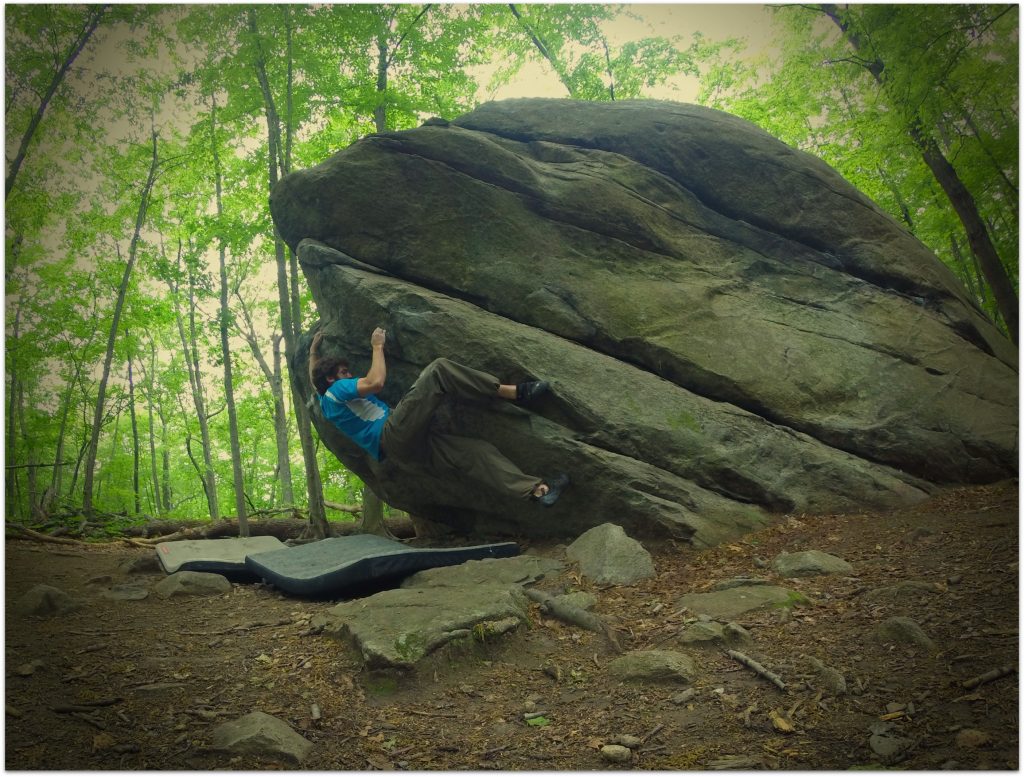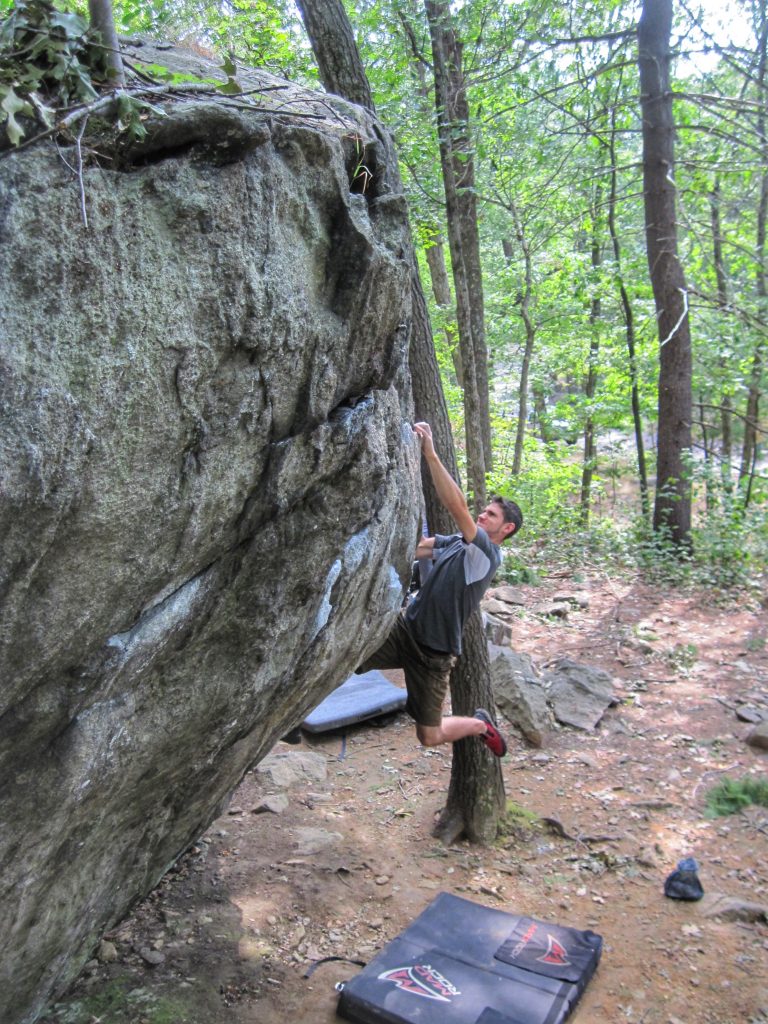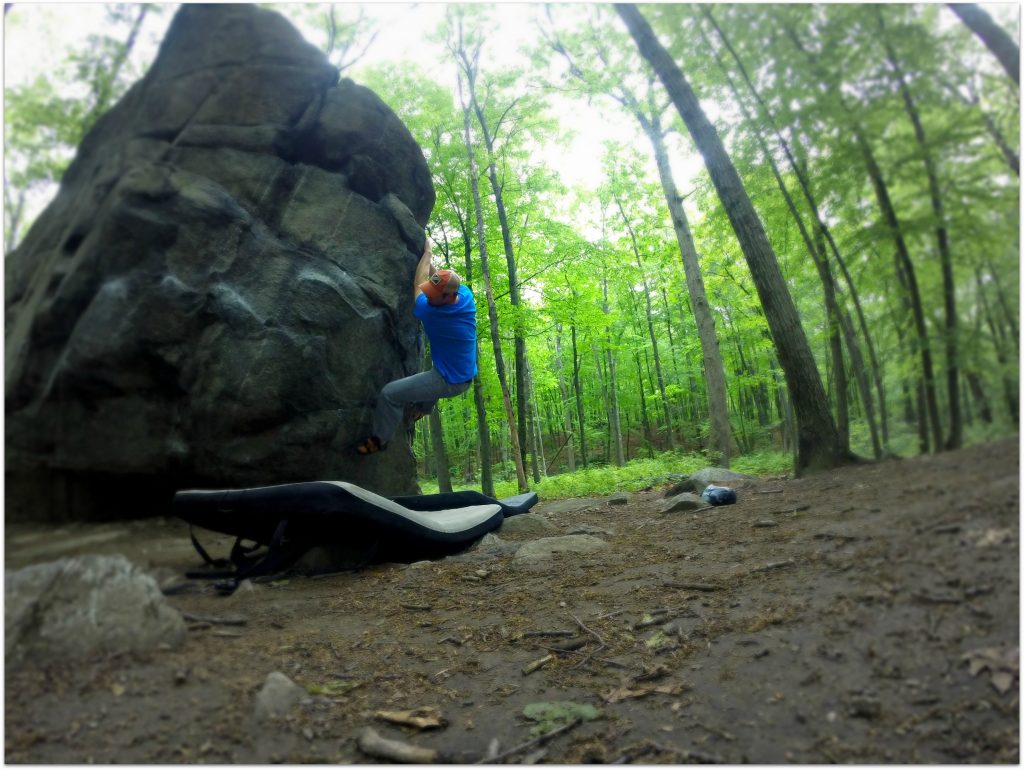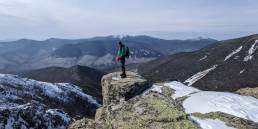To all but the locals, referring to Rhode Island as a climbing destination sounds like a joke. Even some struggle to believe that the nation’s smallest state is also home to some of the region’s best bouldering at Lincoln Woods (or, more simply, “The Woods”). In fact, some climbers even struggle to know where Rhode Island is.
I have two friends from the Ocean State who crisscrossed the U.S. on a climbing trip and claim they were treated like celebrities everywhere from the Red River Gorge in Kentucky to Bishop, California. Why? Because no one had ever met someone from Rhode Island. The most common thing they heard on their trip was, “Rhode Island…That’s near Cape Cod. Right?”

Southern New England’s Secret
Perhaps it’s for the best that the rest of the country hasn’t learned of The Woods’ high-quality granite blocks. After all, it’s located just minutes outside of Providence, an hour from Boston, and an hour and a half from Hartford, making it an easy day trip for many in the Northeast’s major metropolitan areas.
Also, with a plenitude of moderate problems, The Woods is an attractive destination for groups of mixed abilities. Weekends here can get a little crazy, but don’t worry. There are plenty of problems to go around and solitude can be easily found by visiting the more out-of-the-way boulders. Be warned, though: To me, many of these challenges felt hard for their grade.

Why It’s Popular
Like its proximity to the area’s big cities, The Woods’ bouldering logistics are also incredibly convenient. Unlike many New England crags, The Woods has an abundance of parking, with multiple lots to service the diverse user groups frequenting the park. In all my years going here, I have never struggled to find a spot for my car.
Furthermore, a paved road loops around the park and comes within a short distance of many of The Woods’ classic boulders, making navigation a breeze and climbing typically only a short walk away. Additionally, many of its quality sites are adjacent to each other, allowing climbers to hop from boulder to boulder with relative ease.
For me, once snow’s on the ground, I gravitate from climbing shoes to ski boots. However, at Lincoln Woods, you can find something to climb year-round. Some boulders sit in the shade or frequently get a cooling wind, making for comfortable climbing on the warm days of spring and summer. And, for the cold days of late fall and winter, plenty sit in the sun or reside in spots that seem to hold warm air.

So Much to Do
Many will spend years just trying to visit all of the park’s boulders, never mind send every problem. But, for your next visit, consider checking out some of The Woods’ can’t-miss spots at least once and trying some of its must-do problems. Here’s a look at some of its more popular areas, all within an easy walk from your car. And, the best part is, all of these spots are about a five-minute walk from one another, so try them all!
The Great Slab/Wave
A short walk down the road from the park’s main entrance and around the pond brings you to The Great Slab/Wave, considered one of The Woods’ most iconic problems. Depending on who you talk to or where you get your beta, this popular boulder is either called The Great Slab, after the imposing slab you see from the road, or The Wave, after the boulder’s most notorious problem.
Climbing The Wave (V2) is a rite of passage for Lincoln Woods boulderers and should not be missed. Like the many problems here, don’t let its moderate grade fool you. The Wave is hard and combines a wide variety of climbing styles, forcing you into steep terrain and requiring you to use everything from slopers to cracks.
The Ship’s Prow
If the leaves are off the trees, you can see the Ship’s Prow from The Wave, as it’s just across a well-used dirt path. An extremely popular boulder, the Ship’s Prow sees a great deal of traffic, thanks to its proliferation of easy-to-moderate climbs and confidence-inspiring flat landings. It’s not uncommon to find a group of beginners projecting here, next to hardcore climbers warming up.
Although this spot is home to multiple fun problems, the Ship’s Prow Traverse (V1) is the area’s must-do route. You’ll find that it traverses roughly half of the boulder before topping out at the rock’s highest point.
The Iron Cross Boulder
If you look left, across from the pond as you approach The Wave, you’ll see a few boulders scattered up the hill. Following a well-established path, head up the hill to three of The Woods’ most notorious boulders.
On the far right is the the Iron Cross Boulder. Much like The Wave, this boulder gets its name from its most notable problem, The Iron Cross (V4)—which itself is known for a signature iron-cross move.
Shorter people, be warned: The starting hold on The Iron Cross is pretty high off the ground, and I have witnessed all sorts of trickery—from stacking pads to jumping to getting a boost—to reach it. If the starting hold is a little too high, or you’re just looking for something more moderate, the vertical wall facing the road holds a bunch of fun—albeit tall—problems.

Mack’s Traverse
To the left of the Iron Cross Boulder is Mack’s Traverse, which is also named after its signature problem. Mack’s Traverse (V2) crosses nearly all of the boulder’s entirety from right to left and is another classic problem that lures you in by looking easier than it is.
But, to send Mack’s Traverse, you need good beta and even better footwork. Like any classic at a high-traffic area, it seems that the boulder’s every hold is ticked, making where to go misleading at times. Furthermore, the problem is steeper than it appears. As well, because of the incredible amount of traffic it sees, the feet are pretty slippery. In fact, if you forget to keep pressure on them, you’re sure to slide off.
If Mack’s Traverse isn’t happening for you, you’ll find a handful of easier straight-up climbs on the right end and the face. And, if they seemed too easy, just walk down the short hill to the Warm-Up Cave, where you’ll find some of The Woods’ hardest problems.
Warm-Up Cave
Like all listed above, the Warm-Up Cave also sees a lot of traffic due to its high-quality problems and proximity to the park’s entrance. Although you’ll find a number of harder problems here, its easier routes keep beginner and intermediate climbers busy, too.
In spite of its harder climbs, the most notable problem at the Warm-Up Cave is within nearly every man’s reach. Neil’s Lunge (V4) starts in the boulder’s middle on a half-moon flake. Move up the flake to a small crimp, and then, psych yourself up for a dynamic lunge move to better holds.
Looking for something easier? The Cave Warm-Up (V1) follows a fun and obvious line of good holds to the boulder’s highest point. Be warned: Although you’ll encounter all positive holds, at some point, you’ll realize you’re pretty high off the ground, which can be a little intimidating.

These problems are an awesome place to get started, but they are just the tip of the iceberg. And, while Mountain Project or a guidebook has even more listed, over the years, locals have shown me all sorts of hidden variations and challenges. Of course, the only way you get that type of beta is going directly there. Like I said initially, there is no bad time to visit…so, attempt these challenges at the first available opportunity.
Tim Peck
A former child model, Tim spent a portion of his youth gracing the pages of Sunday paper advertisements for many now-defunct department stores. Living responsibility/rent-free with his parents into his thirties, Tim pursued climbing, skiing, and biking while accumulating an impressive amount of time in the mountains (and gear). Now almost grown up, he lives in central New Hampshire with his wife, Australian Shepherd, and cat. Relentlessly pursuing the dream, Tim's modest life ambitions are to ski all 12 months of the year, climb 5.12, and live in a van.
Related Posts
April 12, 2024
Explore Like a Local: The Outdoor Mecca of North Conway, NH
There's a lot to love about this New…
April 3, 2024
5 Things To Do in the Boston Area During Mud Season
Adventure opportunities are abundant…
1 Comment
Comments are closed.





[…] the wind or even avoiding an unexpected spring shower. Even better, because most of the park’s classic boulders are in close proximity, it’s easy to move between them in search of better conditions or a […]